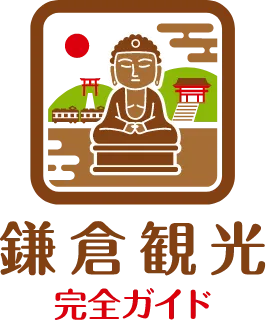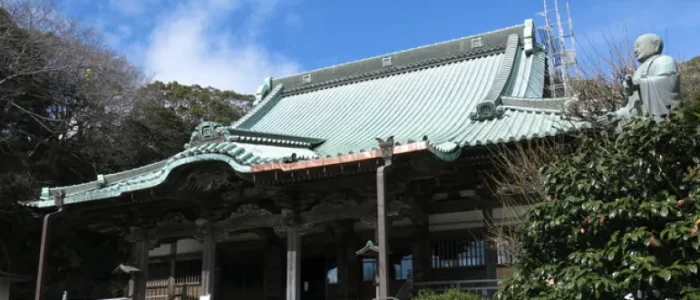Ryuko-ji Temple
What Is Ryukoji Temple?|The Legend of Nichiren and a Miraculous Escape
Located in Fujisawa, just a 3-minute walk from Enoshima Station, Ryukoji Temple (龍口寺) is a historic Nichiren Buddhist temple with deep spiritual roots. This sacred site is known for the dramatic Ryuko-no-Kuchi Persecution, where the Buddhist reformer Nichiren was nearly executed in the late 13th century. According to legend, a celestial light struck the executioner’s sword, sparing Nichiren’s life. The very stone on which Nichiren sat, known as Shikikawa-ishi, is still preserved in the temple’s main hall.
Founded in the mid-14th century by Nichiren’s disciple Nippō, the temple has long been a place of local faith and historical significance.
Highlights|Wooden Pagoda, Guardian Gate & Tranquil Gardens
One of the most eye-catching features of Ryukoji is its wooden five-story pagoda, built in 1910 by Takenaka Corporation. It’s the only remaining wooden pagoda in Kanagawa Prefecture and features intricate carvings that depict Nichiren’s life story, blending artistry and spirituality.
At the temple entrance stands the Nio-mon Gate, donated by a wealthy Osaka merchant in the late 19th century. With its detailed carvings and classical Japanese architecture, it offers a powerful and serene welcome. Other features include Nichiren’s former earthen cell of confinement and a peaceful Japanese garden — ideal for slow, reflective walks.
Spiritual Meaning & Cultural Importance
The temple’s principal object of worship is the Great Mandala (Dai-Mandala), a visual representation of Nichiren’s philosophical work Rissho Ankoku Ron. Ryukoji is more than a place of prayer — it’s a spiritual classroom where Japanese Buddhist history comes alive.
As the site of one of Japan’s most pivotal religious episodes, Ryukoji appeals to both devoted followers and curious cultural travelers alike.
Morning Peace at Ryukoji|Ideal for Guests Staying at Toshi’s Place
With gates opening at 6:00 AM, Ryukoji offers a rare chance to experience sacred Japan in complete peace. If you’re staying at Toshi’s Place, you can enjoy a quiet morning stroll from your accommodation — it’s just a few minutes away on foot. Since Toshi’s Place offers a self-catering, kitchen-equipped style, you’re free to plan your morning as you like and drop by Ryukoji before breakfast without rushing.
From early February to early March, about 1,000 camellia trees burst into bloom, earning Ryukoji the nickname “Temple of Camellias.” The vibrant red, white, and pink blossoms set against historical architecture make it a hidden favorite for photographers.
Seasonal Events & Experiences
Ryukoji is known for its powerful Goshuin calligraphy, which visitors can receive at the temple. The annual Ryuko Hōnane Ceremony, held from September 11–13, features vibrant lantern processions and traditional offerings of sweet rice cakes (botamochi), turning the entire area into a vibrant festival ground.
Depending on your timing, you may be able to witness one of these special events — a rare insight into local religious life.
Access & Opening Hours|Walking Distance from Enoshima
Ryukoji is easily accessible from both Enoden’s Enoshima Station and the Shonan Monorail’s Shonan-Enoshima Station — just a 3-minute walk. If you’re based at Toshi’s Place, it’s an easy morning visit that fits perfectly into a relaxed, flexible itinerary. There’s also parking for 20 cars if you’re exploring by vehicle.
The temple is generally open from 6:00 AM to 5:00 PM, with early mornings offering the most tranquil atmosphere.
Best Time to Visit
For the most serene experience, plan your visit between 6:00 and 8:00 AM. During this time, you’ll be able to appreciate the blooming camellias or other seasonal flowers in total quiet. If you’re staying at Toshi’s Place, this makes for a perfect pre-breakfast walk — flexible, slow-paced, and deeply refreshing.
In camellia season (February–March), the temple becomes a soft explosion of color, with petals carpeting the mossy grounds — ideal for photography and meditative moments.
Nearby Spots You Can Walk to
Extend your morning outing by exploring nearby gems like Enoshima Island, Katase Beach, or the Enoshima Aquarium. Scenic bridges and seaside views are just minutes away.
If you’re continuing along the Enoden Line, other top stops include Hasedera Temple and Kotoku-in (Great Buddha). From Toshi’s Place, you can craft a full day’s itinerary on foot or by train with ease.
Who Should Visit?|Recommended for Different Travel Styles
- History & culture lovers: Discover the real-life drama of Nichiren and feudal Japan
- Photographers & architecture fans: Wooden pagoda, lanterns, and gates galore
- Early risers: Perfect for quiet morning visits from Toshi’s Place
- Flower seekers: Don’t miss the camellia season from February to March
- Travelers avoiding crowds: Mornings and weekdays are especially peaceful
Final Thoughts|Why Ryukoji Belongs on Your Travel List
Ryukoji Temple isn’t just a religious site — it’s a place of deep serenity, storytelling, and cultural depth. From the towering pagoda to camellia-lined paths, every element invites reflection.
And thanks to the location near Toshi’s Place, it’s easy to visit at your own pace, especially in the early morning. With a stay that lets you cook your own breakfast and walk where your heart leads, Ryukoji becomes more than a stop — it becomes a cherished memory.res, and serene environment make it a must-visit for those seeking to explore Japan’s rich spiritual and historical heritage.

